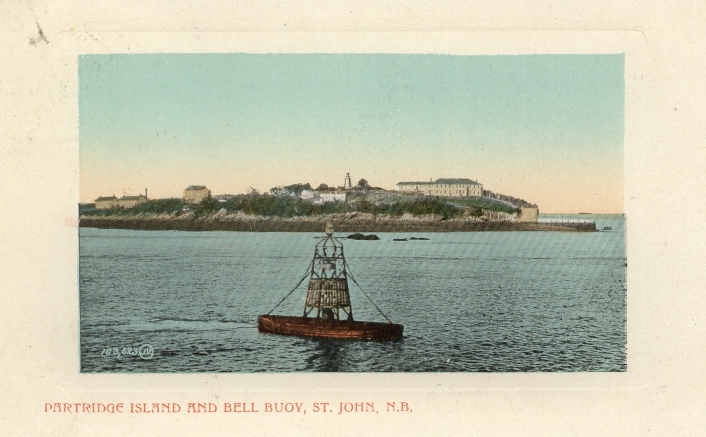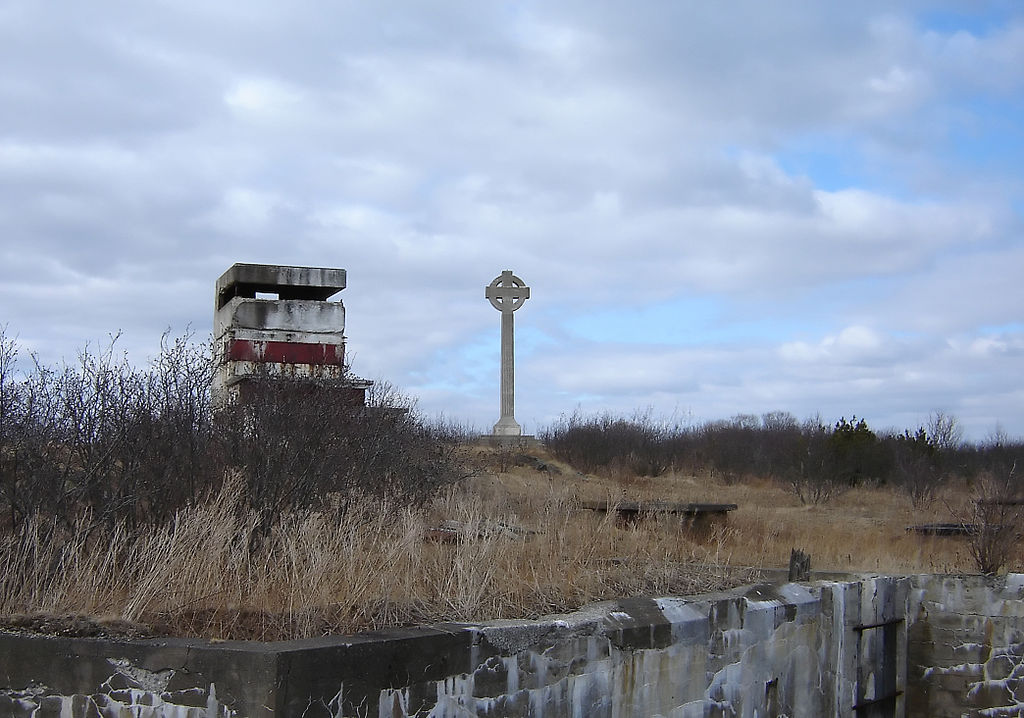Partridge Island is located in the Bay of Fundy, about 1 km from the shoreline and the city of Saint John, New Brunswick. The island was set aside as a quarantine station in 1785 and operated as such between 1830 and 1941. Many immigrants arriving to Canada by ship, including thousands of Irish in 1847, were isolated on the island before being allowed to enter the country. This was done in an effort to prevent the spread of infectious diseases common on overcrowded vessels. In 1974, the Partridge Island quarantine station was designated a national historic site. Other important events are associated with the island, including the installation of the world’s first steam-operated fog alarm in 1859 (see also Robert Foulis).
Wolastoqiyik
The Wolastoqiyik have long resided along the Saint John River in New Brunswick and Maine, and the St. Lawrence River in Quebec. Partridge Island, known in Wolastoqiyik as Quak-m’kagan’ik or “a piece cut out,” is part of their traditional territory.
Wolastoqiyik mythology includes stories about the origins of Partridge Island. At least two of these stories involve Glooscap, a supernatural figure who appears in the stories of several Algonquian-speaking nations (see also Indigenous Languages in Canada). In one story, it is said that Glooscap used a stick to break a beaver dam at Reversing Falls on the Saint John River. He did this to force a group of beavers from their nearby lodge, so that he could hunt them. The sod that made up the dam was carried away on the river. One of these pieces of sod became Partridge Island.
In another story, we are told that Glooscap lived with his grandmother in a stone canoe. When Glooscap became lonely, his grandmother told him that there were other people living along the Saint John River. When they arrived in the Saint John Harbour, the stone canoe ran aground and became Partridge Island.
Geography

A postcard depicts Partridge Island and a bell buoy, c. 1905
Partridge Island is approximately 0.6 km long and 0.3 km wide, making for a total area of 0.18 km2. It is located at the mouth of Saint John Harbour in the Bay of Fundy. The island is a 300 million-year-old volcanic ash deposit. It is now sparsely covered by birch, spruce, willow and alder.
Lighthouse and Foghorn
In 1791, New Brunswick’s first lighthouse was built on Partridge Island to provide a safe passage into the harbour. More firsts followed. In 1859, the world’s first steam-operated fog alarm, invented by civil engineer Robert Foulis, was installed on the island. In 1905, New Brunswick’s first radio station, made by the Marconi Company and used for nautical communication, was built there.
Military Station
In 1800, a signal station, gun platform and barracks were built on Partridge Island. During the War of 1812, the island battery was a principal point of defence. The battery was again used during the Fenian Raids of 1866. During the First and Second World Wars, Partridge Island played an important role in defending the Saint John Harbour. In 1947, the island’s military station closed.
Quarantine Station
In 1785, the Royal Charter of Saint John set aside Partridge Island as a quarantine station. The station was first used 45 years later, in 1830. At the time, quarantine was the best-known defence against the spread of infectious diseases such as typhus, yellow fever and cholera. While American port cities had already established quarantine stations for immigrants arriving on ships from Europe and elsewhere, Partridge Island was the first quarantine station in British North America. A quarantine station at Grosse-Île, Quebec was established in 1832.
One of the first vessels to disembark at Partridge Island was the Feronia. It arrived on 11 June 1830 in the Port of Saint John, carrying 120 Irish passengers. When John Boyd, a physician, examined the immigrants, he found evidence that at least one person had had smallpox during the voyage. He recommended that the immigrants be quarantined at Partridge Island. New cases of smallpox soon appeared among the ship’s passengers. The mayor of Saint John ordered residents not to approach the island, and constables were dispatched in order to enforce this regulation.
In a letter published in the New Brunswick Courier, Boyd described the initial accommodations on the island: “Tents made of some boards, over which were spread sails, constituted their covering; the weather having been extremely wet and cold, they afforded very imperfect shelter.” On 4 September 1830, Boyd published another letter in the Courier, this time announcing the end of the quarantine.
Authorities eventually built a shelter for those quarantined on the island, sometimes referred to as a “pest house.” The island continued to operate as a quarantine station until 1941.
Great Irish Potato Famine: 1847

A Celtic cross commemorates Irish immigrants who died of typhus while quarantined on Partridge Island.
The Partridge Island quarantine station received more immigrants in 1847 than in any other year. This was a result of the Great Irish Potato Famine. Between 1846 and 1848, the potato crop in Ireland failed. Potatoes were a staple food for the majority of Irish people, and millions faced starvation. Many chose to leave the country, resulting in the largest wave of Irish immigration in Canadian history. They travelled on overcrowded ships, where many developed typhus, a disease caused by a strain of bacteria and spread by body lice.
The quarantine station at Grosse-Île received the majority of Irish immigrants to British North America in 1847. Partridge Island was the second busiest point of entry. That year, 2,000 Irish people were quarantined at Partridge Island because of a typhus epidemic; 601 of them are buried in a mass grave on the island.

 Share on Facebook
Share on Facebook Share on X
Share on X Share by Email
Share by Email Share on Google Classroom
Share on Google Classroom



